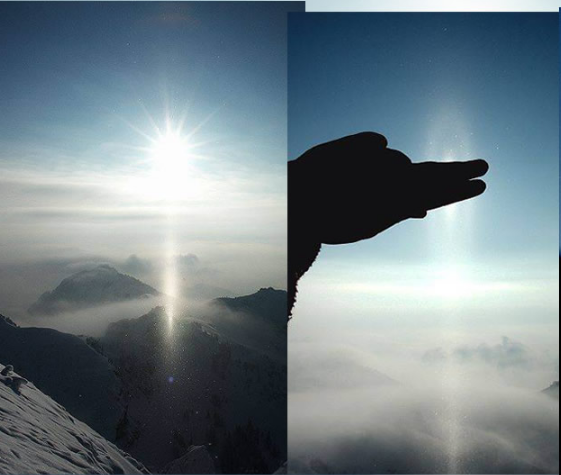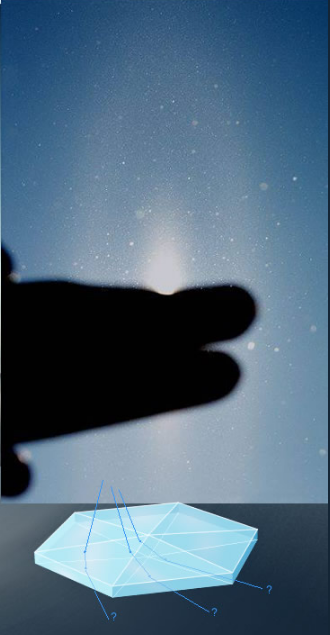Wendelstein Elliptical Halo
The Phenomenon of the Wendelstein Elliptical Halo
The Wendelstein Elliptical Halo is a fascinating atmospheric optical phenomenon that occurs under specific weather conditions. It was first captured by Claudia Hinz, an avid photographer of atmospheric optics, on March 13th, 2006, from Mount Wendelstein in Germany. This rare display occurred amidst a temperature of -17°C, where diamond dust had formed due to dissipating stratus clouds in the valley.
One of the prominent features of this display was the presence of a bright lower sun pillar/subsun. However, what truly captured attention was the appearance of a unique elliptical halo. Unlike the typical circular halos that are more commonly observed, elliptical halos are small and easily missed unless one looks for them carefully with the sun well shielded.
Claudia's photograph revealed that the elliptical halo consisted of at least two rings. The outer ring had a long axis measuring approximately 8° and a short axis of about 3°. Inside this outer ring was an inner ring, which was approximately 2° tall and had a width of around 0.5°. It is worth noting that the size of elliptical halos seems to vary and may be influenced by the solar altitude.
The formation mechanism of these elliptical halos is still a subject of study and debate among atmospheric optics enthusiasts. One possible explanation is that they are formed from pyramidal ice crystals with improbably obtuse angles. However, this interpretation is not yet conclusive as ray tracing simulations have not precisely replicated the observed characteristics of the rings in these halos.
Despite the uncertainty surrounding their formation, the Wendelstein Elliptical Halo serves as a reminder of the astonishing complexity and beauty of atmospheric optics. It is yet another example of how nature can create intricate and captivating phenomena that challenge our understanding.
To fully appreciate and capture these elusive halos, it is crucial to be observant and patient. Here are some tips for spotting and photographing elliptical halos:
- Choose a location with a clear view of the sky, away from any obstructions.
- Shield your eyes from the direct sunlight to avoid discomfort and potential damage.
- Look for a circular halo around the sun as a starting point, as this may indicate the presence of an elliptical halo.
- Once you have located the circular halo, carefully scan its surroundings for any subtle deviations or distortions in shape.
- If you spot an elliptical halo, make sure to take photographs from different angles and distances to capture its full extent.
- Experiment with different camera settings and exposure times to enhance the visibility and details of the halo.
- Share your findings and photographs with the atmospheric optics community, contributing to our collective knowledge and appreciation of these phenomena.
In conclusion, the Wendelstein Elliptical Halo is a captivating atmospheric optics phenomenon that showcases the intricate nature of our atmosphere. Its unique characteristics and formation mechanisms continue to intrigue researchers and photographers alike. By understanding and observing these phenomena, we can deepen our appreciation for the wonders of our natural world. So keep your eyes to the sky, for you never know what optical marvels may await you.


Elliptical Halo imaged by Claudia Hinz (atmospheric optics) from Mount Wendelstein, Germany on
13th March '06. Images ©Claudia Hinz, shown with permission.
The display started at a temperature of -17 C. Diamond dust had formed from dissipating stratus in the valley. The first halos were a bright lower sun pillar/subsun. A rare elliptical halo then became visible. Like the that in the previous OpticsPOD, Claudia's elliptical had at least two rings. The outer was of 8° long axis and 3° short with an inner ring 2° tall and ~0.5° wide. Elliptical halos are small and easily missed unless looked for carefully with the sun well shielded. They appear to have no fixed size and if indeed they are formed from improbably obtuse pyramidal crystals their size must change with solar altitude. However, the pyramidal crystal interpretation is suspect because ray tracing simulations have so far not matched the ring characteristics precisely.
Note: this article has been automatically converted from the old site and may not appear as intended. You can find the original article here.
Reference Atmospheric Optics
If you use any of the definitions, information, or data presented on Atmospheric Optics, please copy the link or reference below to properly credit us as the reference source. Thank you!
-
<a href="https://atoptics.co.uk/blog/wendelstein-elliptical-halo/">Wendelstein Elliptical Halo</a>
-
"Wendelstein Elliptical Halo". Atmospheric Optics. Accessed on November 21, 2024. https://atoptics.co.uk/blog/wendelstein-elliptical-halo/.
-
"Wendelstein Elliptical Halo". Atmospheric Optics, https://atoptics.co.uk/blog/wendelstein-elliptical-halo/. Accessed 21 November, 2024
-
Wendelstein Elliptical Halo. Atmospheric Optics. Retrieved from https://atoptics.co.uk/blog/wendelstein-elliptical-halo/.